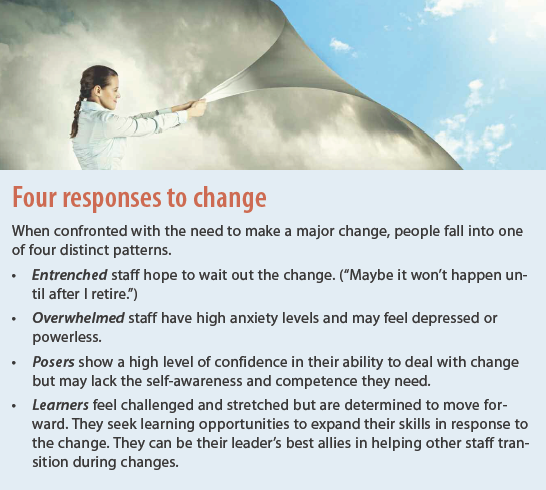Jake, a critical care nursing director, works for a large healthcare system that has invested heavily in testing the use of robots to support operational tasks and provide new ways for physicians to interact with patients. During his monthly staff meeting, Jake presents an overview of the robotic products and what they’re designed to do. He’s surprised at how some of the senior nurses react; they immediately criticize the initiative as just another attempt to reduce staffing costs and dehumanize health care.
The meeting quickly lapses into a discussion of the “good old days” in nursing. Jake explains that the robotics venture is exploratory and the jury is still out on this cutting-edge technology. Although he supports his organization’s willingness to be an early adopter, some of his staff clearly feel otherwise. He realizes part of his role as a leader is to help them release their attachments to the past and embrace innovative changes.
Over the past decade, the pace of change in healthcare delivery has been relentless. Leaders like Jake have been challenged to help staff adapt to these changes. Tim Porter-O’Grady, an expert on organizational innovation, conflict, and change, observed that part of nurse leaders’ work is to “close the door on old models of health delivery and clinical work…and face the future viewing the entire landscape to develop a workable vision.”
Helping staff release their attachments to the past and embrace new innovations can be hard work, as Jake will learn. When we’re attached to something—be it a person, situation, or practice—we want circumstances to be a certain way and tend to resist changes in our expectations. Change can be quite emotional for some people. Often, it means letting go of something you’ve valued in the past.
Why we attach to the past
Life can be a delicate balance of holding on and letting go. Changing our viewpoints on issues or abandoning old behaviors involves both a loss of what was and a leap into the unknown. This can make us feel insecure about our work—and it can be exhausting. There’s safety in what we know and risk in what we don’t know.
For some people, it’s a challenge to think positively about the creative possibilities that accompany innovation. That’s why the reaction to any change can be so emotional. Nursing staff may worry that introducing robots into health care could mean fewer jobs. Older nurses may feel insecure about their technological skills and lack confidence in their ability to master new products or processes. In contrast, younger nurses who grew up in the digital age view technology as an integral part of their work and may react differently.
Five strategies to help staff let go
Jake needs to understand that as a leader, he plays a key role in framing the context of change for his staff. His support of his organization’s new initiative is important in gaining staff buy-in and can help his staff release their attachments to old ways of delivering care. Introducing robotic products into the workplace involves what management educator Barbara Mackoff describes as an adaptive change. This type of change requires us to let go of old ideas and experience some uncertainty and loss in what’s comfortable. To help staff let go, use these five leadership strategies.
1 Meet staff where they are in the acceptance and transition process.
Not everyone accepts change in the same way or on the same timeline. Leadership expert Kerry Bunker suggests that to avoid frustration, we must meet people wherever they are in the change process. Accept that some people won’t be as far along as you might want them to be. Where they are depends on their comfort with change (ability to take on new learning) and capacity for change (ability to learn what’s required). As a leader, you need to accept where people are in the acceptance process.
2 Frame the issues in easily understood language.
With the changes stemming from healthcare reform and declining reimbursements, organizations have good reason to look for new and different ways to innovate their care delivery. Jake should frame the robotics initiative as an innovative way to help his staff see the need for new technologies. Staff depend on their leaders to help them understand the meaning of innovations. How leaders use language to frame people, situations, and events has important consequences for how staff make sense of the world and their actions.
3 Recognize people have different responses to change.
Bunker proposes that a person’s response to change can occur in four distinct patterns—entrenched, overwhelmed, poser, and learner. (See Four responses to change.)
4 Help people identify where and how they can fit into the change.
In most situations where we’re asked to change, we’re replacing the old with the new and unfamiliar. But change can lead to a new, brighter future—and leaders need to convey this. For instance, Jake can cite recent changes in the hospital environment, such as introduction of electronic health records and medication barcoding, to demonstrate to staff how they’ve been able to incorporate these innovations into their current practice successfully. Leaders who stay calm, truthful, and optimistic in their communications help prevent the spread of misinformation and reduce staff anxiety.
5 Give people hope.
Every situation has a silver lining, and leaders need to be the first to help everyone see what it is. An optimistic attitude can be energizing and contagious, motivating your staff to do their best. To achieve success, you need to expect success.
Focusing on the future
For many nurses with long careers, the chaos and complexity of today’s environment challenges the sense of order. When we feel fearful, clinging to what worked in the past can be comforting.
Leaders should be skilled in working in the present with an eye toward the future. When you think about the past, it’s good to reminisce but important to keep in mind the phrase, “That was then. This is now.” Here are three key ways to stay future focused.
• Track trends. Major trends in our environment—work, home, or the world—almost always are preceded by many signs, large and small. If you’ve been paying attention to healthcare trends, such as use of robotic technology in manufacturing and operating rooms, applying this technology to other areas of health care shouldn’t be a surprise.
• Look for opportunities to reinvent. Management guru Peter Drucker said, “The best way to predict the future is to create it.” This is great advice. If things clearly are changing and innovation is needed, why not embrace the change and develop an innovator’s mindset? Just because you’ve been doing things a certain way doesn’t mean that’s the best way to do it now. When you’re passive about change, it’s easy to feel like a victim of what’s happening. You’ll be much more willing to embrace something you take an active role in implementing.
• Talk to younger nurses. Investing in relationships with younger team members helps you understand today’s environment. The pace of change in health care doesn’t seem to frustrate younger nurses. In their short careers, they’ve learned to adapt quickly to a rapidly changing environment. They’re full of optimism and can give you great hope for the future.
The future belongs to those who create it
When talking to his staff about their attachment to the past, Jake could use the metaphor of a ship: When the ship has left the dock, you’re either on board or not. The ship won’t head back to port to pick you up.
Sometimes, life and work events match our desires; other times, they don’t. Surrendering our attachments to the past is a choice, but an important—and potentially liberating—one. Whenever you find yourself talking about the good old days of nursing, reflect on what’s to be gained by doing that and whether anyone’s listening. The future belongs to those who create it.
Rose O. Sherman is a professor of nursing and director of the Nursing Leadership Institute at the Christine E. Lynn College of Nursing at Florida Atlantic University in Boca Raton. You can read her blog at www.emergingrnleader.com. Portions of this article were published previously on the author’s blog. Note: Names in scenarios are fictitious.
Selected references
Bunker KA. Introduction. In: Rush S, ed. On Leading in Times of Change. Greensboro, NC: Center for Creative Leadership; 2012.
Kotter JP. Leading Change, With a New Preface by the Author. Boston: Harvard Business Review Press; 2012.
Mackoff BL. AONE leadership laboratory insights: the practice of change leadership. Nurs Lead. 2014;12(6):23-6.
Porter-O’Grady T, Malloch K. Quantum Leadership: Building Better Partnerships for Sustainable Health. 4th ed. Burlington, MA: Jones & Bartlett Learning; 2015.




















1 Comment.
To the Editor:
I find myself in sympathy with the senior nurses who were reluctant to adopt robotic products (“Releasing our Attachments to the Past”). First, the author assumes that change is always good and that resistance to change is always bad – not true! Second, why were the senior nurses not consulted when the robotic products were being considered? They were, after all, senior nurses, people with the knowledge and experience to know how such devices would work (or not) in clinical practice. Moreover, being senior, they have earned the right not to have changes forced on them in such a top-down fashion. This is not an example of resisting change. This is an example of singularly poor management.
Burden S. Lundgren, MPH, PhD, RN